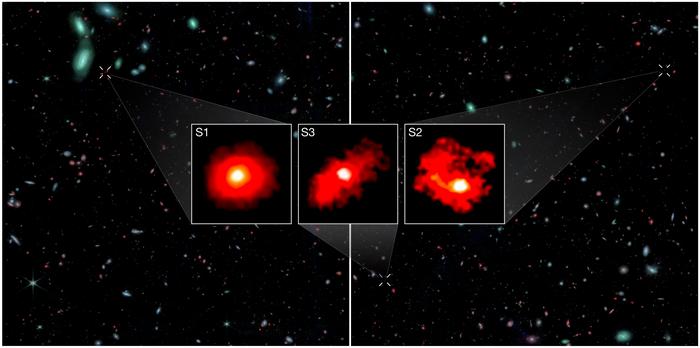A team of scientists using NASA’s James Webb Space Telescope has discovered three impossibly massive galaxies from the dawn of time that are forming stars at rates that shouldn’t be possible. Dubbed the “Red Monsters” due to their dust-enshrouded appearance, these galactic giants emerged less than a billion years after the Big Bang and rival our own Milky Way in mass – a finding that challenges fundamental theories about how galaxies form.
Journal: Nature, November 13, 2024, DOI: 10.1038/s41586-024-08094-5 | Reading time: 5 minutes
Breaking the Rules of Galaxy Growth
In the traditional model of galaxy formation, massive galaxies build up gradually within vast halos of dark matter. As these halos capture gas and dust, only about 20% typically converts into stars. But the newly discovered Red Monsters are shattering this understanding by converting an extraordinary 50% of their available material into stars – a rate two to three times higher than even the most efficient known galaxies from later epochs.
“Our findings are reshaping our understanding of galaxy formation in the early Universe,” says Dr. Mengyuan Xiao, lead author of the study at the University of Geneva. These ancient behemoths were previously invisible to astronomers because they are shrouded in thick clouds of dust that block visible light.
Precision Measurements Reveal the Impossible
The discovery emerged from the JWST’s FRESCO program, which systematically analyzed emission-line galaxies from the universe’s first billion years. Using the telescope’s NIRCam/grism spectroscopy capability, researchers could precisely measure both distances and stellar masses for their complete galaxy sample.
Out of 36 massive dust-obscured galaxies studied, three stood out dramatically. “The massive properties of these Red Monsters were hardly determined before JWST, as they are optically invisible due to dust attenuation,” explains Dr. David Elbaz of CEA Paris-Saclay.
Defying Theoretical Models
While most galaxies in the survey fit existing models, these three Red Monsters pose a unique challenge. They’re not only forming stars at unprecedented rates but also contributing about 17% of all cosmic star formation in their era – despite being rare specimens.
The findings don’t directly conflict with standard cosmology, but they suggest unknown processes must have allowed these early galaxies to achieve such extraordinary star-forming efficiency. Current theoretical models can’t explain how they grew so massive so quickly.
A New Chapter in Cosmic History
“These results indicate that galaxies in the early Universe could form stars with unexpected efficiency,” notes Dr. Xiao. “As we study these galaxies in more depth, they will offer new insights into the conditions that shaped the Universe’s earliest epochs. The Red Monsters are just the beginning of a new era in our exploration of the early Universe.”
Future observations with both the James Webb Space Telescope and the Atacama Large Millimeter Array will search for more of these mysterious giants and attempt to uncover the secrets of their impossibly rapid growth.
Glossary
- Dark matter halo: Invisible mass surrounding galaxies that helps bind them gravitationally
- Emission-line galaxy: Galaxy whose spectrum shows bright lines at specific wavelengths
- Star formation efficiency: Rate at which available gas converts into stars
- NIRCam/grism spectroscopy: Technique that spreads light into its constituent wavelengths to measure galaxy properties
- Stellar mass: Total mass of all stars in a galaxy
Test Your Knowledge
1. What makes these galaxies’ star formation rates so unusual?
They convert 50% of their available matter into stars, compared to the typical maximum of 20% in most galaxies – a rate 2-3 times higher than the most efficient known galaxies from later times.
2. How significant is their contribution to early universe star formation?
These rare galaxies account for 17% of all cosmic star formation at redshifts between about five and six.
3. Why weren’t these galaxies discovered before the James Webb Space Telescope?
They are optically invisible due to being shrouded in thick dust that blocks visible light.
4. How many similar galaxies were found in the complete survey?
The survey studied 36 massive dust-obscured galaxies in total, with only three qualifying as ultra-massive “Red Monsters.”
Enjoy this story? Subscribe to our newsletter at scienceblog.substack.com
If our reporting has informed or inspired you, please consider making a donation. Every contribution, no matter the size, empowers us to continue delivering accurate, engaging, and trustworthy science and medical news. Independent journalism requires time, effort, and resources—your support ensures we can keep uncovering the stories that matter most to you.
Join us in making knowledge accessible and impactful. Thank you for standing with us!

